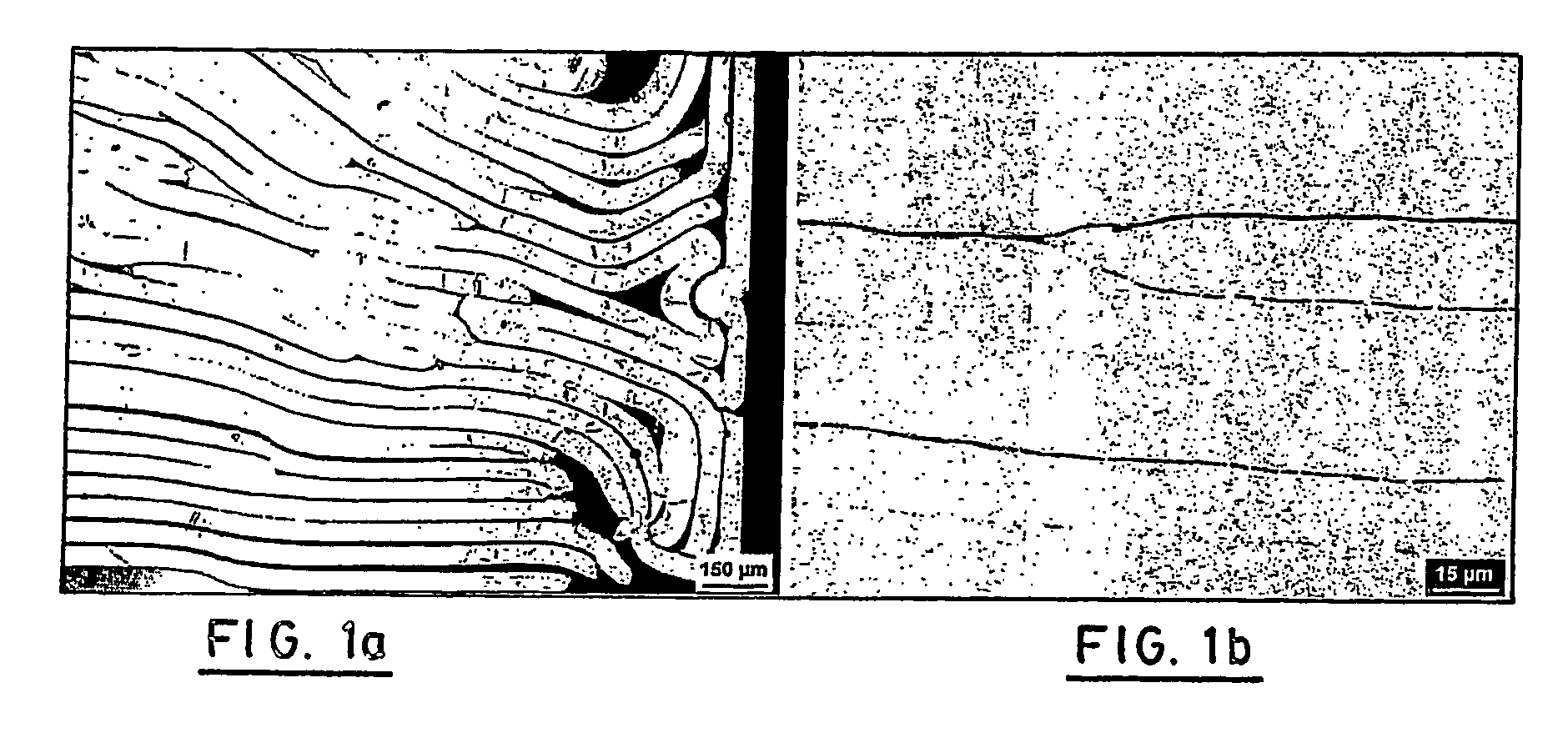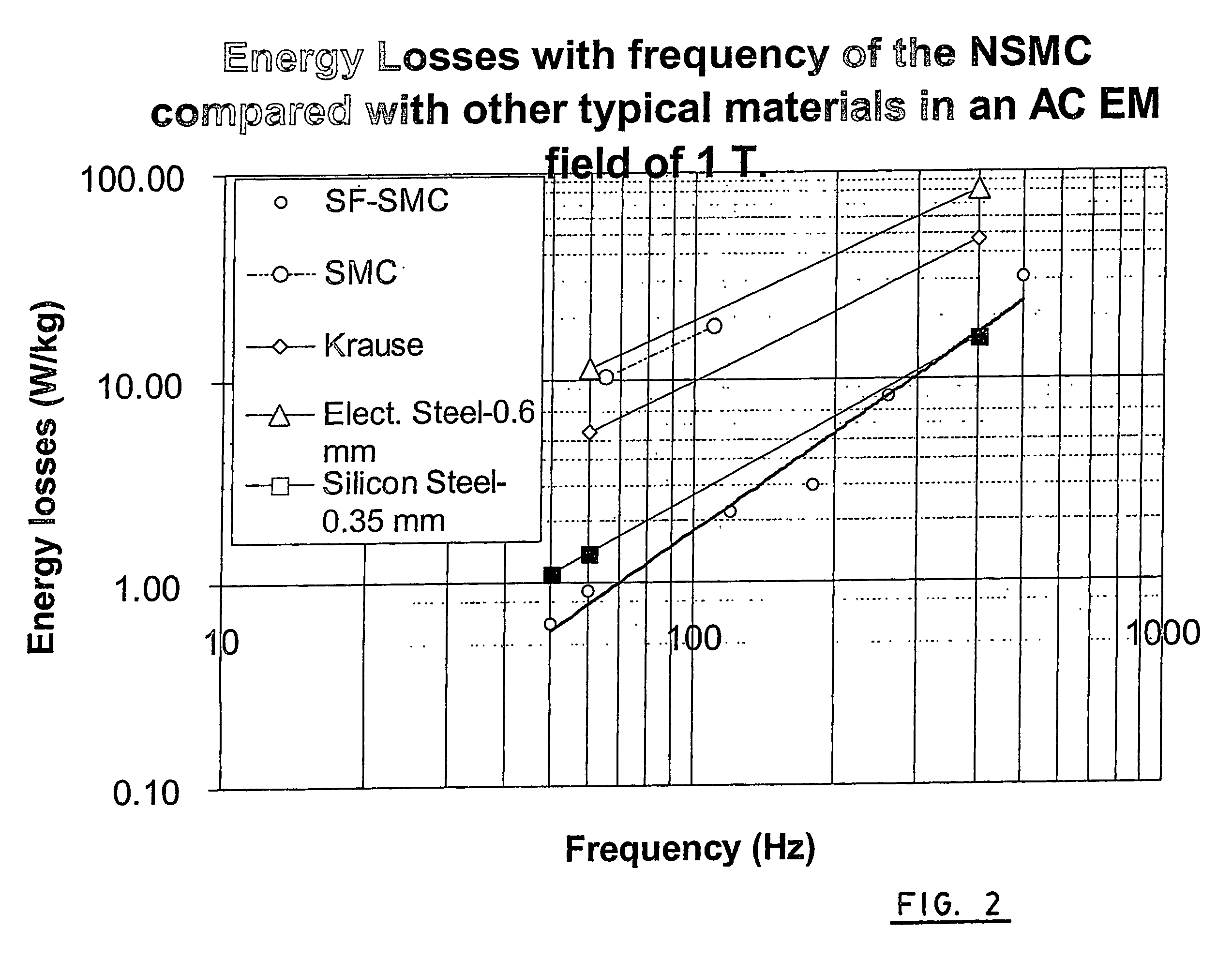High performance magnetic composite for AC applications and a process for manufacturing the same
a composite material and high-performance technology, applied in the field of soft or temporary magnetic composites for ac applications, can solve the problems of energy loss, hysteresis loss and eddy current loss, conversion of electric energy to thermal energy, etc., and achieve the effect of improving magnetic properties and lowering hysteresis and eddy current losses
- Summary
- Abstract
- Description
- Claims
- Application Information
AI Technical Summary
Benefits of technology
Problems solved by technology
Method used
Image
Examples
example 1
[0076]The process used to do the rings for which results are reported on table 1 (SF-SMC FeNi sintered) and FIG. 2 at an induction of 1.0 Tesla is the following:[0077]Coating one side of a 50 μm thick Fe-47.5% Ni foil with 0.4 μm of alumina in D.C. pulsed magnetron sputtering reactive process,[0078]Annealing the ribbon during 4 hours at 1200° C. under pure hydrogen,[0079]Cutting the ribbon to form square lamellar particles of 2 mm by 2 mm sides,[0080]Mixing the particles with 0.5% acrawax in a “V” type mixer during 30 minutes,[0081]Filling a plastic pre-filling die with the mixture, vibrating the pre-filling die during filling, pressing at 1 MPa,[0082]Sliding the content of the pre-filling die into the steel die for cold pressing, pressing at 827 MPa and ejecting the compact,[0083]Delubing the compact at 600° C. during 15 minutes,[0084]Heating the compact at 1200° C. under pure hydrogen during 30 minutes, and[0085]Cooling the compact at 20° C. / min.
[0086]A part of the same dimensions...
example 2
[0087]The process used to do the rings which results are reported in table 1 (SF-SMC FeNi forged) on FIG. 3 at an induction of 1.5 Tesla is the following:[0088]Coating one side of a 50 μm thick Fe-47.5% Ni foil with 0.4 μm of alumina in D.C. pulsed magnetron sputtering reactive process,[0089]Annealing the ribbon during 4 hours at 1200° C. under pure hydrogen,[0090]Cutting the ribbon to form square lamellar particles of 2 mm by 2 mm sides,[0091]Mixing the particles with 0.5% acrawax in a V type mixer during 30 minutes,[0092]Filling a pre-filling die with the mixture, vibrating the pre-filling die during filling, pressing at 1 MPa,[0093]Sliding the content of the pre-filling die into the die for cold pressing, pressing at 827 MPa and ejecting the compact,[0094]Heating the compact at 1000° C. in air during 3 minutes and forging it at 620 Mpa,[0095]Annealing the compact at 800° C. during 30 minutes under pure hydrogen.
[0096]A part of the same dimensions made with uncoated laminations ga...
example 3
[0097]The process used to do the rings which results are reported on Table 1 (SF-SMC Fe-3%Si sintered) is the following:[0098]Ribbons of iron containing 3% of silicon are produced by the technology of Planar Flow Casting (The melt product is directly poured on a high speed rotating wheel).[0099]The 50 μm thick ribbon is coated with a spray of a Sol-Gel solution made with aluminum isopropoxyde and dried by reaching 150° C. in a continuous process.[0100]The coated ribbon is annealed under pure hydrogen at 1200° C. during 2 hours and cooled to room temperature slowly.[0101]The ribbons are sprayed another time with the Sol-Gel process.[0102]The ribbons are then sprayed with EBS using an electrostatic charging system and cut into 2 mm by 2 mm square particles.[0103]Particles are poured in a plastic pre-compacting die and pre-compacted at 150 lb per square inch (1 MPa).[0104]The pre-compacted particles are transferred to a steel die (powder metallurgy compacting press) and cold pressed at...
PUM
| Property | Measurement | Unit |
|---|---|---|
| coercive force | aaaaa | aaaaa |
| temperature | aaaaa | aaaaa |
| thickness | aaaaa | aaaaa |
Abstract
Description
Claims
Application Information
 Login to View More
Login to View More - R&D
- Intellectual Property
- Life Sciences
- Materials
- Tech Scout
- Unparalleled Data Quality
- Higher Quality Content
- 60% Fewer Hallucinations
Browse by: Latest US Patents, China's latest patents, Technical Efficacy Thesaurus, Application Domain, Technology Topic, Popular Technical Reports.
© 2025 PatSnap. All rights reserved.Legal|Privacy policy|Modern Slavery Act Transparency Statement|Sitemap|About US| Contact US: help@patsnap.com



